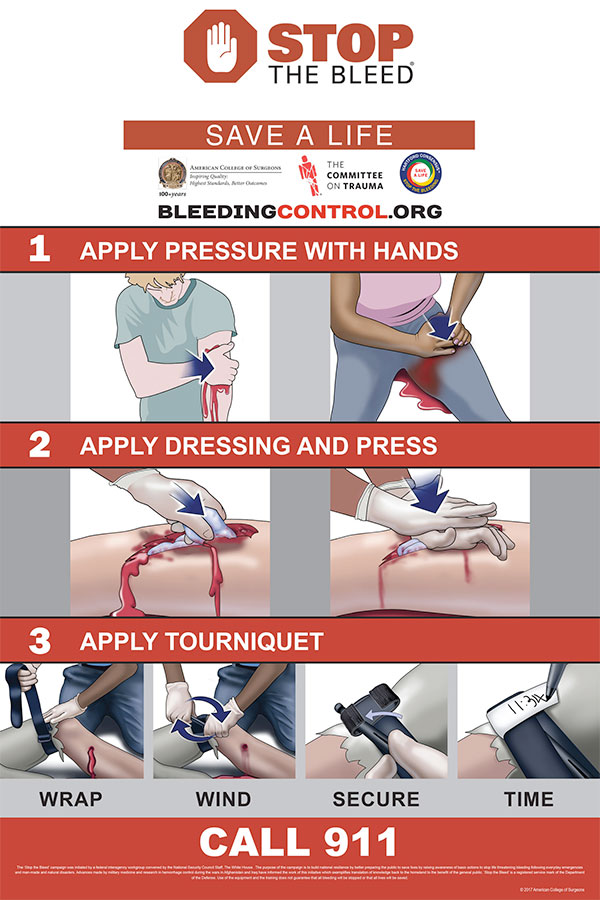Broken Bones
A broken bone is a very common injury to sustain and it is often very obvious to the patient from either the sound or feeling. Look for these signs and symptoms in the limb:
- Looks deformed, discolored, or swollen
- Pain when moving
- Crackling sound
- Inability to move
- Bleeding
- Bone protruding
If someone has broken a bone,
- Call the ambulance.
- Keep the limb as stable as possible and in the position found.
- Keep the extremity elevated in order to reduce the swelling.
- The EMT/Paramedic will splint the limb, by immobilizing the joints above and below the break, and by controlling any bleeding.
Sprains & Strains
Both sprains and strains are very common injuries. A strain involves damage to a muscle, while a sprain is due to damage to a joint. Strains are commonly seen in the back, hamstrings, forearm, and hands. Sprains are more commonly experienced at the ankle, knee, wrist, and fingers. These injuries could be due to a direct instance if trauma or just due to overuse. The signs and symptoms of both are very related, including:
- Pain
- Swelling
- Bruising
- Tenderness to touch
- Limited movement
Muscle weakness or spasms may also be experienced with strains. Both of these injuries are more common in people who are physically active.
Recommended treatment of these injuries follows the pneumonic RICE:
- R – rest the injured area as much as possible
- I – ice the injury for 10 min 3x a day to minimize swelling
- C – compression wraps can provide comfort
- E – elevate the area to decrease swelling
Seek further care if the pain is sharp and affects regular routine.
Burns
Burns are a very common injury, but can be very devastating depending on how long the patient was exposed to heat. Burns are classified as first, second and third degree.
- First degree burns:
- Most common
- Often caused by sun exposure
- Keep the area clean and remind patient to stay hydrated
- Second degree burns:
- Present with a blister that appears moist
- Very painful
- Can have a white, waxy appearance
- Third degree burns
- Vary in color (white, red, or brown)
- Often dry, leathery, or hard
- May be some clotted blood
- Very little/no pain because of nerve death
- Will not heal without doctor

The first thing to do when you come into contact with a burn is to stop the burning process by cooling the skin with cool water (NOT ICE). Running water is best if possible. This will also serve to numb the pain of a burn. Remove any clothing that may have been burned, as well as tight clothing and jewelry. Burns will quickly cause swelling, so restrictive items are a concern.
If the burn is minor, after you cool the burn, cover the area with a clean dressing. It is recommended to use a dry sterile bandage to minimize the chance of infection.
If the burn does not seem superficial, call emergency services and raise the burned area above the level of the heart if possible.
Bleeds
When a patient is bleeding, it is often very controllable, but bleeding can be very serious if it is not controlled. After calling the ambulance, try to locate the source of any bleeding. To do this, look for a place where there is continuous bleeding, a large-amount of blood, or pooling of the blood. This spot may be hidden by clothing and there may be many spots, so check the whole body and ask the patient if they can locate the worst pain.
Once you have found the bleed, apply firm direct pressure to the wound UNLESS the wound is to the head and a skull fracture is possible. Use gauze, cloth, or clothing when putting pressure on the bleed. If pressure stops the bleeding, do not release pressure until emergency medical services asks you to.
For bigger wounds, pressure will not be enough. In this case, you will want to pack the wound with gauze or another soft fabric, by inserting your hand and pushing gauze fully into the wound. This can be very painful, but also life-saving. After the wound is packed, apply direct pressure again.
If available, the last tool for a very extensive bleed is to apply a tourniquet. To do this properly, you will place the tourniquet 2 to 3 inches above the wound and tighten it until the bleeding stops. Do not place a tourniquet on an elbow or knee, and do not remove the tourniquet until help arrives. A properly placed tourniquet will likely be painful due to how tight it must be to stop bleeding and the limb will also start to lose feeling. It is important to note that if a tourniquet is not available, slowing the bleed through wound packing and direct pressure is still vitally important.
